2021 MERCEDES-BENZ GLE COUPE trailer
[x] Cancel search: trailerPage 223 of 466
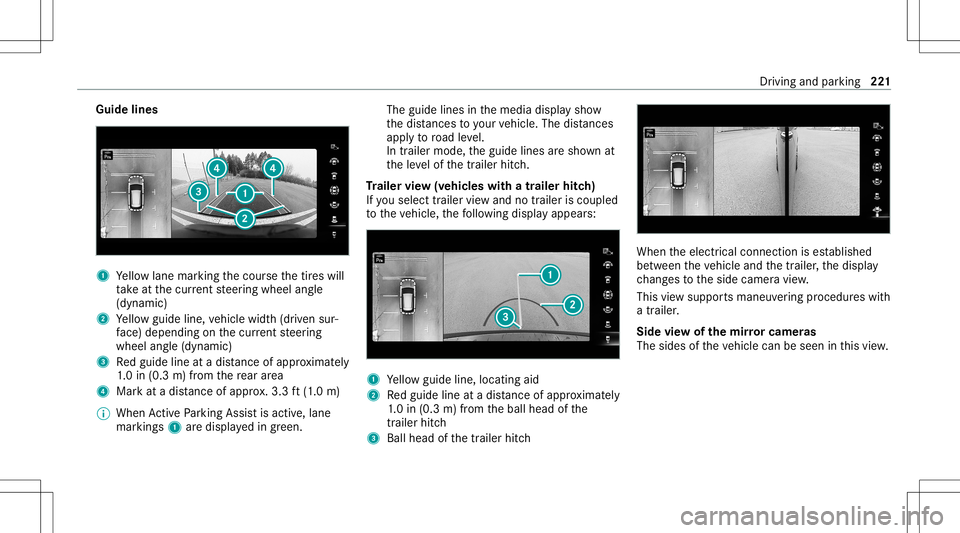
Guide
lines 1
Yello wlane markingth ecour sethetir es will
ta ke atthecur rent steer ing wheel angle
(dynamic)
2 Yello wguide line,vehicle width(dr iven sur‐
fa ce) dep endi ngon thecur rent steer ing
wheel angle(dynamic)
3 Redguide lineatadis tance ofapprox imat ely
1. 0 in (0.3 m)from there ar area
4 Markat adis tance ofappr ox.3.3 ft(1.0 m)
% When ActivePa rking Assistis act ive, lane
mar kings1 aredispla yedin green. The
guide linesinthemedia displaysho w
th edis tances toyour vehicle. Thedistances
ap ply toroad leve l.
In trailer mode, theguide linesaresho wnat
th eleve lof thetrailer hitch.
Tr aile rvie w(vehic leswith atraile rhitc h)
If yo usele cttrailer viewand notrailer isco upled
to theve hicle, thefo llo wing displa yappear s: 1
Yello wguide line,locat ingaid
2 Redguide lineatadis tance ofapprox imat ely
1. 0 in (0.3 m)from theball head ofthe
tr ai le rhi tc h
3 Ballhe ad ofthetrailer hitch When
theelectr icalconnect ionises tablished
be tween theve hicle andthetra iler ,th edispla y
ch ang estotheside camer avie w.
This viewsuppor tsmaneuv ering procedur eswit h
a trailer .
Side viewof themir rorca mer as
The side sof theve hicle canbeseen inthis vie w. Dr
iving and parking 22
1
Page 226 of 466
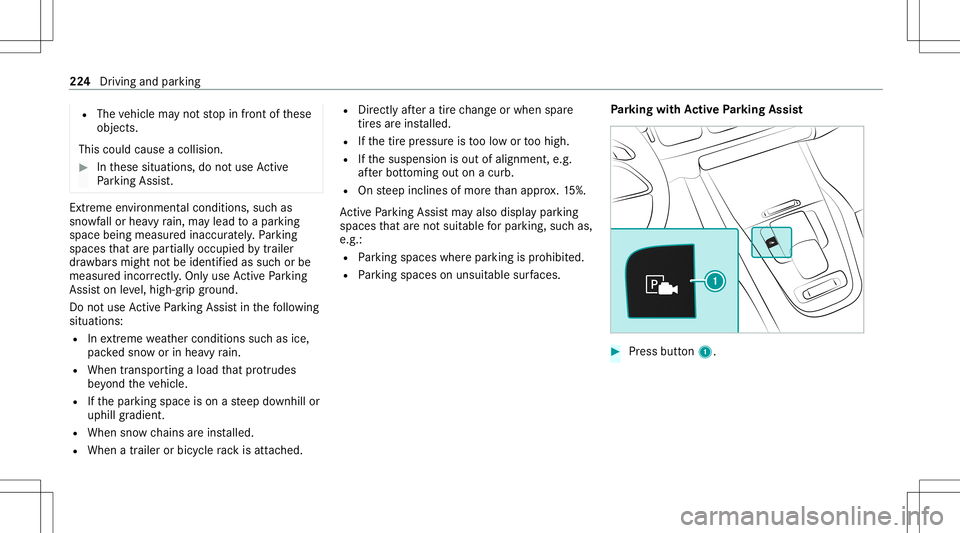
R
The vehicle mayno tst op infront ofthese
objec ts.
This could cause acollision. #
Inthese situation s,do notuse Active
Pa rking Assist. Ex
treme environm entalcon dition s,suc has
sno wfall orhea vyrain, ma ylead toapar king
spac ebein gmeas ured inac curately. Pa rking
spaces that arepar tiallyoccupied bytrai le r
dr aw bar smight notbe ident ified assuc hor be
measur edincor rectly .Only useAc tivePa rking
Ass iston leve l,high- grip grou nd .
Do notuse ActivePa rking Assistin thefo llo wing
situat ions:
R Inextreme weather condition ssuc has ice ,
pac kedsno wor inhea vyrain.
R When transpor tingaload that protru des
be yond theve hicle.
R Ifth epar king space ison ast eep downhill or
uphill gradient.
R When snowch ains areins talled.
R When atrailer orbicy clerack isatt ached. R
Direct lyafte ra tir ech ang eor when spare
tir es areins talled.
R Ifth etir epr essur eis toolow or toohigh.
R Ifth esuspension isout ofalignment ,e.g.
af te rbo ttoming outonacurb.
R Onsteep inclin esofmor eth an appr ox.15 %.
Ac tivePa rking Assistma yalso displa ypar king
spaces that areno tsuit able forpar king, suchas,
e.g.:
R Parking spaces wherepar kingis prohibit ed.
R Parking spaces onunsuit ablesurfaces. Pa
rking withAc tiv ePa rking Assis t #
Press butt on1. 22
4
Driving andparking
Page 234 of 466

The
exitwa rning isonl yan aid and nota subs ti‐
tut efo rth eatt ent ion ofvehicle occupants. The
re sponsibili tyforopening andclosi ngthedoor s
and forlea ving theve hicle remains withth eve hi‐
cle occupants.
Sy stem limit s
Blin dSpo tAs sis tand ActiveBli nd Spo tAssi st
ma ybe limi tedin thefo llo wing situat ions:
R ifth er eis dir ton thesensor sor thesensor s
ar eobscur ed
R inpoor visibility ,e.g. due tofog, hea vyrain or
sno w
R ifth er ear enar row vehicles, e.g.bicycles or
mo torbik es
R ifth ero ad has very wide ornar row lanes
R ifve hicles areno tdr iving inthemiddle of
th eir lane
Wa rnings maybe issued inerro rwhen driving
close tocrash barrier sor similar continuous lane
bor ders.Alw aysmak esur eth at ther eis suf fi‐
cie ntdist anc eto theside forot her traf fic or
obs tacle s. Wa
rnings maybe interru pte dwhen driving along‐
side long vehicles, forex am ple truc ks,fo ra pr o‐
long edtime.
Blind SpotAssis tis no toper ationa lwhen reve rse
ge ar iseng aged.
Blin dSpo tAs sis tand theex itwa rning areno t
opera tionalwhen atrailer iscoupled totheve hi‐
cle and theelectr icalconnect ionhas been cor‐
re ctl yes tab lished.
The exitwa rning maybe limit edinthefo llo wing
situat ions:
R when thesensor sar eco veredby adjac ent
ve hicles innar row par kingspac es
R when people approachth eve hicle
R intheeve ntofstatio naryor slo wlymo ving
obj ect s
Fu nction ofbrak eapp lication (Activ eBlind
Spo tAssis t)
If Ac tiveBli nd Spo tAssi stdetects arisk ofaside
im pact inthemonit oring rang e, acou rse-co r‐
re cting brak eap plica tion iscar ried out. This is
designed tohelp youavo idacollis ion. The
cour se-cor recting brak eap plica tion isavaila‐
ble inthespeed rang ebe twee nap prox imat ely
20 mph(3 0km/h) and125mp h(2 00 km/h) . &
WARNIN GRisk ofacci dent despite
br ak eapplication ofActiveBli nd Spo t
Assi st
A cou rse-co rrect ing brak eapplication cannot
alw ayspr ev ent acollision. #
Alw aysst eer ,br ak eor accelera teyour‐
self ,espe ciallyif Ac tiveBli nd Spo t
Assi stwa rnsyo uor mak esaco urse-
co rrect ing brak eapplication. #
Alw aysmaint ainasaf edis tance atthe
sides. 232
Driving andparking
Page 235 of 466
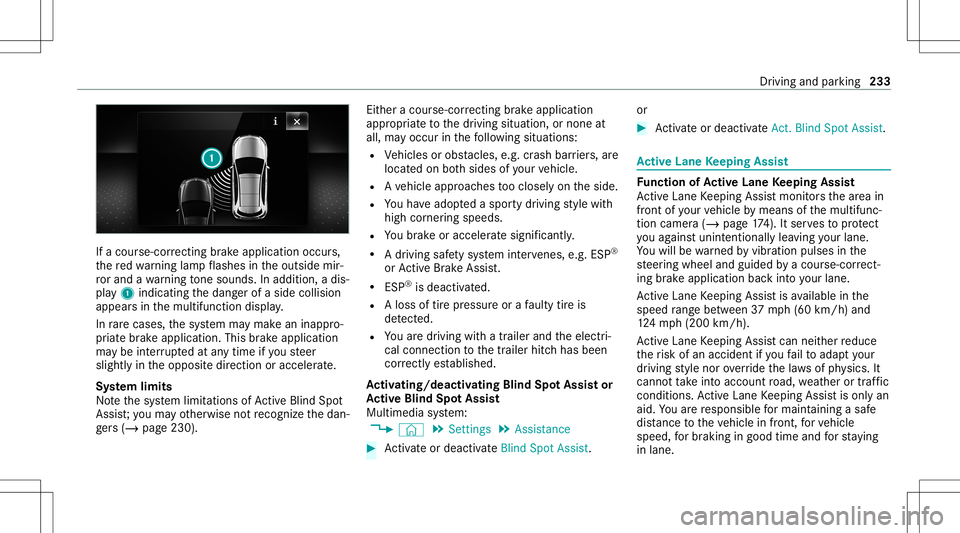
If
acour se-cor recting brak eap plica tion occu rs,
th ere dwa rning lam pflashes intheoutside mir‐
ro rand awa rning tone sou nds. Inadditio n,adi s‐
pl ay 1 indic atingth edang erofaside collision
appear sin themultifunc tiondispla y.
In rare case s,thesy stem maymak ean inappr o‐
pr iat ebr ak eapplication. Thisbrak eapplication
ma ybe interru pte dat anytime ifyo usteer
slightl yin theopposit edir ect ion oraccelera te.
Sy stem limit s
No tethesy stem limit ations ofActiveBli nd Spo t
Assi st;yo uma yot her wise notre cogni zethedan‐
ge rs (/ pag e230) . Eit
her acour se-correcting brak eap plica tion
ap propr iate to thedr iving situation ,or non eat
all, mayoccur inthefo llo wing situat ions:
R Vehicles orobs tacle s,e.g. crash barrier s,are
locat edon both sides ofyour vehicle.
R Ave hicle approaches tooclosel yon theside.
R Youha ve adop tedaspor tydriving style wit h
high corner ing speeds.
R Youbr ak eor acc elerat esign ifican tly.
R Adr ivi ng safety system interve nes, e.g.ESP ®
or ActiveBr ak eAssi st.
R ESP ®
is de acti vated.
R Aloss oftirepr essur eor afa ulty tireis
de tected.
R Youar edr ivin gwit hatrailer andtheelectr i‐
cal con nect iontothetra iler hitchhas been
cor rectl yes tablished.
Ac tiv atin g/deac tivatin gBli nd Spo tAs sist or
Ac tiv eBli nd Spo tAs sist
Multimedia system:
4 © 5
Set ting s5
Assist ance #
Activateor deacti vate Blind Spot Assist. or #
Activateor deacti vate Act. Blind Spo tAssi st. Ac
tiv eLan eKe eping Assist Fu
nction ofActiv eLan eKe eping Assist
Ac tiveLa ne Keeping Assistmonit orsth ear ea in
fr ont ofyour vehicle bymeans ofthemultifunc ‐
tion camer a(/ page17 4).It ser vesto protect
yo uag ains tunin tentio nallyleav ing your lane .
Yo uwill bewarned byvibr ation pulses inthe
st eer ing wheel andguided byacour se-cor rect‐
ing brak eap plica tion back intoyo ur lane .
Ac tiveLa ne Keeping Assistis available inthe
speed rang ebe twee n37 mph(60 km/h) and
12 4mp h(2 00 km/h) .
Ac tiveLa ne Keeping Assistcan neither reduce
th erisk ofan accident ifyo ufa ilto adap tyo ur
dr ivin gst yle nor override thelaws ofphysics. It
can notta ke intoacc ount road, weather ortraf fic
condi tions.Ac tiveLa ne Keeping Assistis onl yan
aid. Youar ere sponsible formaint ainingasaf e
dis tance totheve hicle infront, forve hicle
speed, forbr aking ingood timeandforst ay ing
in lane. Dr
ivin gand parking233
Page 238 of 466
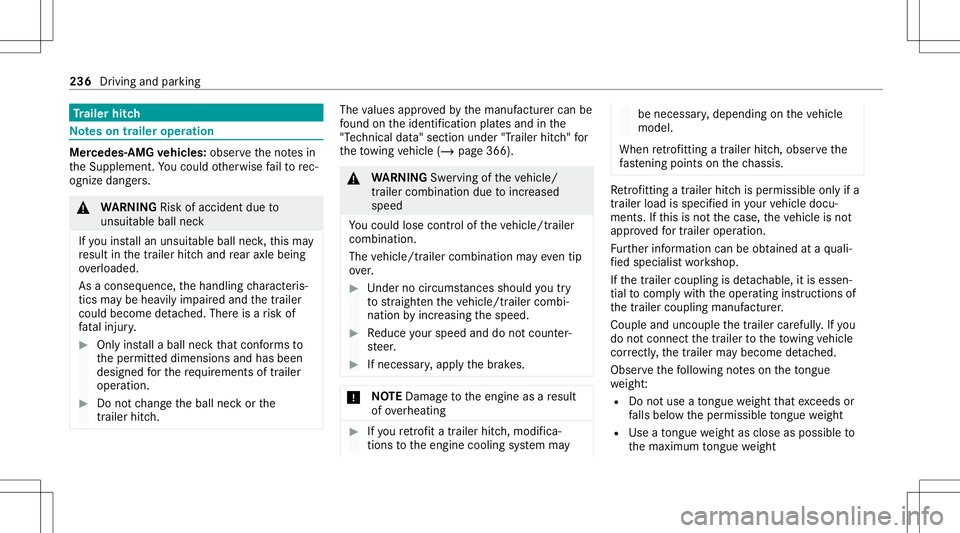
Tr
aile rhitc h No
teson trailer operation Mer
cedes‑AMG vehicl es:obse rveth eno tesin
th eSupplement .Yo uco uld other wise failto rec‐
ogni zedangers. &
WARNIN GRisk ofacci dent dueto
uns uitable ballneck
If yo uins tallan unsuit ableballneck,this ma y
re sult inthetrailer hitchand rear axle being
ove rloaded.
As aconseq uence, thehandling charact eris‐
tic sma ybe hea vilyim pair edand thetrailer
could become detach ed. Ther eis arisk of
fa ta linj ury. #
Onlyins talla ball neckth at con form sto
th eper mitt eddimension sand hasbeen
designed forth ere qu iremen tsof trailer
opera tion. #
Donotch ang eth eball neckor the
tr ai le rhi tc h. The
values approvedby themanuf acturercan be
fo und ontheidentif ication platesand inthe
"T ec hn ical data"sec tionunde r"T ra iler hitch"for
th eto wing vehicle (/page366). &
WARNIN GSw erving oftheve hicle/
tr ailer combination duetoinc reased
spee d
Yo uco uld lose contro lof theve hicle/tr ailer
combination.
The vehicle/tr ailercombination mayeve ntip
ove r. #
Under nocircums tances should yo utry
to stra ight entheve hicle/tr ailercombi‐
nation byinc reasin gth espeed. #
Reduce your spee dand donotco unt er‐
st eer . #
Ifneces sary,appl yth ebr ak es. *
NO
TEDama getotheengine asare sult
of ove rheating #
Ifyo ure trof itatrai le rhi tc h, mod ifica ‐
tio ns totheengine cooling system may be
neces sary,dependin gon theve hicle
model.
When retrof itti ng atrai le rhi tc h, ob serveth e
fa stening pointson thech assis . Re
trof itti ng atrai le rhi tc his pe rm issible onlyif a
trailer loadisspec ified inyour vehicle docu‐
ments. Ifth is isno tth ecase, theve hicle isno t
appr ovedfo rtr ail er oper ation.
Fu rther information canbeobt ained ataqu ali‐
fi ed specialis two rkshop.
If th etrailer coupling isde tach able, itis esse n‐
tial tocom plywith theoper ating instruction sof
th etrailer coupling manufacturer.
Couple anduncouple thetrailer carefull y.Ifyo u
do notcon nectth etra iler totheto wing vehicle
cor rectl y,thetrailer maybecome detach ed.
Obser vethefo llo wing noteson theto ngu e
we ight :
R Donotuse ato ngu ewe ight that exceed sor
fa lls belo wtheper missible tongu ewe ight
R Use ato ngu ewe ight asclos eas possible to
th emaximum tongu ewe ight 236
Drivin gand parking
Page 239 of 466

Do
notexc eed thefo llo wing values:
R Perm issible towing capac ity
R Perm issible rear axle load oftheto wing vehi‐
cle
R Perm issible gross mass oftheto wing vehicle
R Perm issible gross mass ofthetrailer
R Maximum permissible speedofthetra iler
En sur eth efo llo wing beforest ar tin gajo ur ne y:
R The tirepr essur eon there ar axle oftheto w‐
ing vehicle issetfo ra maximu mloa d
R The lighting ofthecon nect edtrailer isoper a‐
tion al
In theeve ntofincr eased rear axle load, theve hi‐
cle/tra ilercombination mayno texc eed amaxi‐
mum speed of62 mph(1 00 km/h) forre ason s
con cerningth eoper ating permit. This also
applies incount ries inwhic hth eper missible
maximum speedforve hicle/tr ailercombinations
is abo ve62 mph(1 00 km/h).
Ve hicl eswith AIRMA TICorE-AC TIVE BODY
CONT ROL:ifth esoc ketof thetra iler hitchis
occupied, e.g.byatrailer orrear bicy clerack , th
eve hicle issetto thenor mal leve lre ga rdless
of thedr ive pr og ram at speed sgr eat erthan
19 mp h(3 0km/h). At
tac hin gth eball neck &
WARNIN GRisk ofacci dent andinjury
due toan incorrectly installed ballcou‐
pling
If th eball coupling isno tins talled and
eng aged cor rectly ,it ma ybeco medetach ed
dur ing traveland endan gerot her road user s.
Ther eis arisk offata linj ury. #
Installand secur eth eball coupling as
descr ibedintheball coupling manufac‐
tur er's installation instruct ions . #
When theball coupling hasbeen instal‐
led, ensureth at itis cor rectly secu red
bef oreev erytrip. &
WARNIN GRisk ofacci dent dueto an
inc orrectl yins talled and secur edball
couplin g
If th eball coupling hasnotbeen correctly
ins talled and secur ed,thetra iler can become
de tach ed. #
Installand secur eth eball coupling as
descr ibedintheball coupling manufac‐
tur er's installation instruct ions . #
When theball coupling hasbeen instal‐
led, ensureth at itis cor rectly secu red
bef oreev erytrip. Re
quirement s:
R The vehicle issecur edagains tro lling away. Dr
iving and parking 23
7
Page 240 of 466
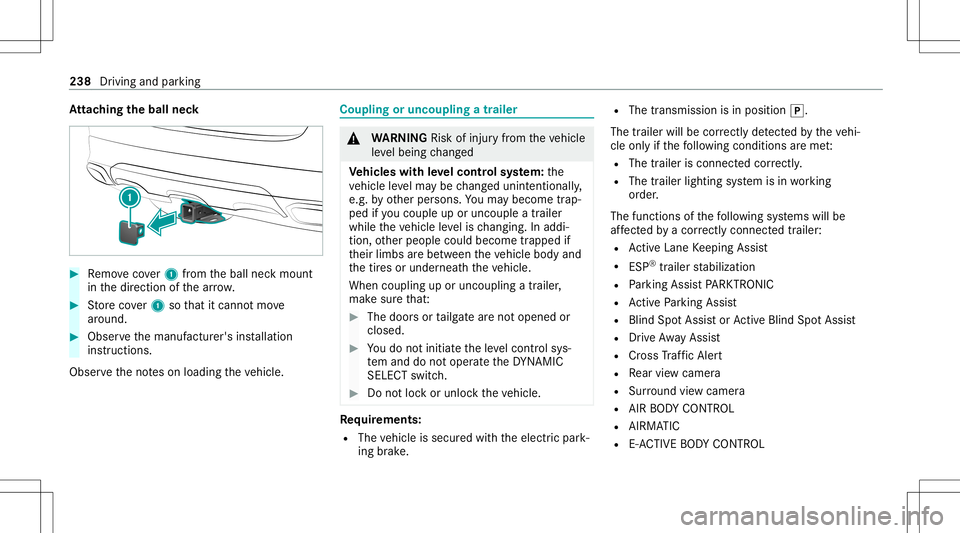
At
tac hin gth eball neck #
Remo vecover1 from theball neckmount
in thedir ect ion ofthear row . #
Storeco ver1 sothat itcan notmo ve
ar oun d. #
Obse rveth emanuf acturer'sinstallation
ins truct ions .
Obser vetheno teson loadi ngtheve hicle. Coupling
oruncoupling atrailer &
WARNIN GRisk ofinju ryfrom theve hicle
le ve lbeing chang ed
Ve hicl eswith leve lcontr olsystem: the
ve hicle leve lma ybe chang edunin tentio nally,
e.g. byother persons. Youma ybec ome trap‐
ped ifyo uco uple uporunc ouple atrailer
while theve hicle leve lis ch ang ing.In addi‐
tio n,other people couldbecome trapped if
th eir limbs arebe tween theve hicle body and
th etir es orunder neathth eve hicle.
When coupling uporuncoupling atrailer ,
mak esur eth at: #
The door sor tailg atear eno topen edor
clos ed. #
Youdo notini tiat eth eleve lcon trol sys‐
te m and donotoper ateth eDY NA MIC
SELE CTswitc h. #
Donotloc kor unloc kth eve hicle. Re
quirement s:
R The vehicle issecur edwithth eelectr icpar k‐
ing brak e. R
The transmission isin position 005D.
The trailer willbecor rectly detected bytheve hi‐
cle onlyif th efo llo wing condition sar eme t:
R The trailer isconn ectedcor rectl y.
R The trailer lighting system isin wo rking
or der .
The func tionsof thefo llo wing systems willbe
af fect ed byacor rectl yconnect edtrai le r:
R ActiveLa ne Keeping Assist
R ESP®
tra iler stabiliz ation
R Parking AssistPA RK TRONI C
R ActivePa rking Assist
R Blin dSpo tAss istor ActiveBli nd Spo tAssi st
R Drive Aw ayAssi st
R Cross Traf fic Aler t
R Rear vie wcam era
R Surround viewcam era
R AIR BO DY CONTR OL
R AIRMA TIC
R E-AC TIVE BODY CONTR OL 238
Driving andparking
Page 241 of 466
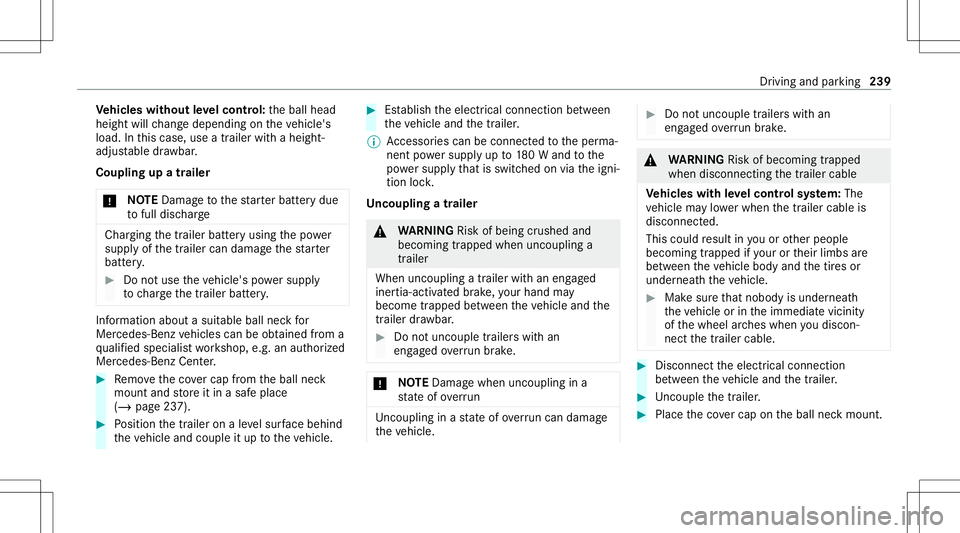
Ve
hicl eswithout leve lcontr ol:theball head
height willchang edepen dingon theve hicle's
load. Inthis case, useatrailer withaheight -
adjus table draw bar .
Coupling upatrailer
* NO
TEDama getothest ar terbatt erydue
to full disc harg e Cha
rging thetra iler batt eryusing thepo we r
supply ofthetra iler can damag eth est ar ter
batt ery. #
Donotus eth eve hicle's powe rsupp ly
to charge thetrailer battery. Inf
ormation abouta suit ablebal lnec kfo r
Mer cedes-Ben zve hicles canbeobt ained from a
qu alif ied spec ialistwo rkshop, e.g.anaut hor ized
Mer cedes-Benz Center. #
Remo vetheco vercap from theball neck
mount andstor eit in asaf eplace
(/ page23 7). #
Position thetra iler onaleve lsur face beh ind
th eve hicle andcouple itup totheve hicle. #
Establish theelectr icalconnect ionbetween
th eve hicle andthetra iler .
% Access oriescan beconnect edtotheper ma‐
nen tpo we rsupp lyup to180W and tothe
po we rsupp lythat isswit ched on via theigni‐
tion lock.
Un coup lingatrailer &
WARNIN GRisk ofbei ng crus hed and
beco ming trap ped whenunco upling a
tr ai le r
Whe nunco upling atrai le rwi th an eng aged
ine rtia-ac tivated brak e, your han dma y
bec ome trapped between theve hicle andthe
tr ai le rdr aw bar . #
Donotuncouple trailer swit han
eng aged ove rrunbr ak e. *
NO
TEDama gewhen uncouplin gin a
st at eof ove rrun Unc
oupling inast at eof overru ncan dama ge
th eve hicle. #
Donotuncouple trailer swit han
eng aged ove rrunbr ak e. &
WARNIN GRisk ofbeco ming trap ped
whe ndisconnecti ngthetrailer cable
Ve hicl eswith leve lcontr olsystem: The
ve hicle maylo we rwhen thetra iler cable is
discon nected.
This could result inyouor other people
becoming trapped ifyo ur or their limbs are
be tween theve hicle body andthetir es or
under neathth eve hicle. #
Mak esur eth at nobody isunde rneat h
th eve hicle orintheimmediat evicin ity
of thewheel arch es when youdisc on‐
ne ct thetrailer cable. #
Disc onnect theelectr icalconnect ion
be tween theve hicle andthetra iler . #
Uncou ple th etra iler . #
Place theco vercap ontheball neckmount . Dr
iving andparking 239